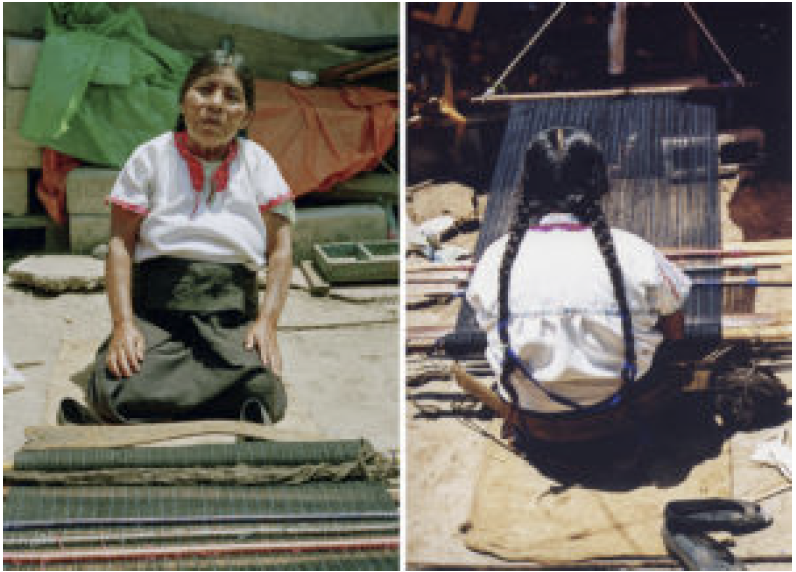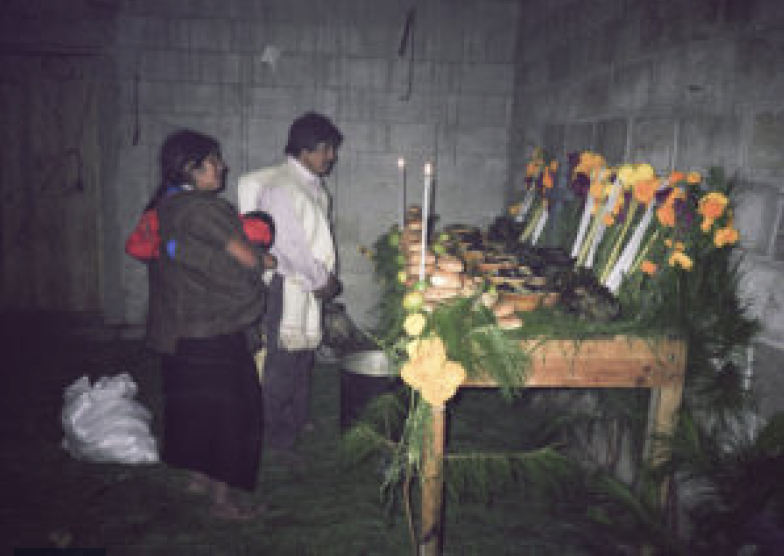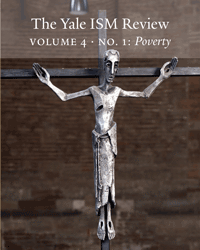Carlota Duarte

“Cocina” — Wan spiljel wa’elal ja jwatz Soyla / Doña Soyla está repartiendo la comida / Doña Soyla is serving out the food. Armando Vásquez Morales, 1997. Tojolabal ethnic group.
Many diverse factors mark the unique context of the Chiapas Photography Project. Its geography and landscape are very much part of its character: the large array of climates is due to altitude variations ranging from volcanos, forested highlands, and mountains to various lower elevations that contain a complex system of pine-oak forests, valleys, tropical rainforests, coastal plains, and beaches. Chiapas is one of the most environmentally rich and diverse regions of Mexico and, as a consequence, suffers from exploitation of various kinds.
The colonial city of San Cristobal de Las Casas, with a 2010 population of 186,000, is the commercial center for the highlands. Its tourist industry is served both by the luxurious commercial tourist services and itinerant indigenous vendors who are mostly women. In sharp contrast to the material prosperity of tourists, the street environment commonly involves poor, malnourished, often shoeless women and children weaving among the tourists, offering handcrafts for sale or begging. Outside the cities, the population is dispersed among rural areas, small town centers, and tiny hamlets, many of which are accessible only by footpaths.
The diversity of Chiapas is also cultural: around 70% of the population is mestizo, mixed race and Spanish-speaking, while the other 30% or so is indigenous. Many of the indigenous are monolingual in one or another indigenous language, and relatively few can read or write in either their first language or Spanish.

“Telar” diptych — Li antze ja’ sbi Xtumin tey ta sjal tsekil. / La mujer llamada Dominga está tejiendo una enagua. /
Dominga is weaving a traditional skirt. Xunka’ López Díaz, 2000. Tsotsil ethnic group.
Political and social unrest have troubled the region, including an armed uprising in 1994 of the Zapatista Army of National Liberation. Its ongoing effects, such as blockades, marches, protests, and social conflict among different communities and ethnic and religious groups, have involved both ordinary citizens, the military, and paramilitary groups. These have prompted specific fears and an ongoing environment of worry because of the interruption of daily life in transportation, schooling, and commerce. Perhaps worst of all, the state itself is increasingly militarized, ostensibly to protect the tourist industry, but the indigenous communities simultaneously suffer in a variety of ways from such forces and the flourishing paramilitary groups. This situation even gives rise to conflict between different indigenous communities, adding yet another source of tensions for daily life.

“Altar” — Tey lechajtik ve’lil ta sba mexa xchi’uk kantilaetik sventa sk’in santo. / Están puestos la comida y las velas sobre la mesa para los muertos. / The food and candles for the dead are on the table. Genaro Sántiz Gómez,1996. Tsotsil ethnic group.
Natural disasters add to an atmosphere of instability. These result from earthquakes and a six-month rainy season that can prompt landslides and other natural effects that close roads and limit communication. These are not sufficiently relieved by the generally inadequate services in health and education and are made worse by the lack of electricity and paved roads. More than seven of every ten persons live in poverty, some of this already extreme poverty becoming increasingly precarious. It is thus not surprising that many find themselves forced into migration, whether internal—from the countryside to cities—or out-migration, to seek work elsewhere in Mexico or in the United States. Because Chiapas shares a border with Guatemala, it also serves as the entry point for migrants from Central and South America, as well as for people from countries outside the Americas who seek entry into the United States via Latin America. Sadly, many indigenous people suffer from the indignity of another, non-material poverty: discrimination and exclusion, ridicule, exploitation, and being treated as children, their culture reduced to merely folkloric entertainment for tourists.
Of special note, and all too easily missed from the bases of tourist hotels and restaurants, is the fact that their undeniable material poverty exists alongside a wealth of cultural expression within a natural setting of rich natural life. Art-making within such a context can enhance the lives of the participants both through enjoyment and by the community enrichment of shared learning experiences. A real solidarity stems from the mutual support, understanding, and empathy that go along with the photography activities.
The people have long been researched, photographed and represented by outsiders, but I wanted to offer them the opportunity to decide how to use photography for themselves.

“Fiesta” diptych — Te sk’in kajkanantike ya sbentesik jch’ultatik a. / En la fiesta del Santo Patrono de San Idelfonso hacen caminar a los santos. / During the feast of the patron Saint Idelfonso there is a procession with the saints’ statues. Juana Girón Intzín, 2013. Tseltal ethnic group.
My interest was, and remains, in addressing what I feel to be an injustice; at the same time, as a visual artist myself, I felt an aesthetic eagerness to see the images that the project participants would make. As one of the Mexican states with a significant number of ethnic groups, most of them Mayan, Chiapas was of particular interest to me. The people have long been researched, photographed and represented by outsiders, but I wanted to offer them the opportunity to decide how to use photography for themselves. My role has been not just to provide cameras and materials but to support the participants in the use of photography, with others of their own families and communities but also with other ethnic groups. Soon after starting the project, it became clear that sharing the photographers’ work with outsiders would complement the work and serve to extend its reach, providing the opportunity for appreciation of the lives and cultures of Mayan peoples.
Thus, the title of this reflection is not about the poverty of the people of Chiapas and the wealth of the affluent West. It instead speaks of the fact that these people, poor in material things, are also rich.
About the Project
The Chiapas Photography Project (CPP) provides indigenous Maya peoples of Chiapas, Mexico with opportunities for cultural and artistic self-expression through photography. Since 1992, more than 500 indigenous men and women from diverse ethnic groups and religious backgrounds have learned how to use photography as a mode of personal expression, and many have undertaken projects that include members of their communities.
CPP is based in San Cristóbal de Las Casas, the commercial and cultural center of the Chiapas Highlands. The Project’s activities are both local and global in scope. CPP photographers have exhibited their work in their own towns, as well as in museums, galleries, and alternative spaces in Mexico and abroad. More important perhaps, is that the participants have photographs of that which is important to them and their communities; new skills have provided self-confidence and an eagerness to learn new things. CPP has earned recognition from the Mexican and international press, the academic community, and the art world. CPP has also provided opportunities for volunteers and photographers to work with indigenous participants in CPP activities.

“Retrato” diptych — Li jmuk Ristinae tey sk’eloj li jlok’tavaneje xchi’uk sbats’i k’u’. / Mi hermanita Cristina está mirando la cámara con su traje tradicional. / My little sister Cristina is looking at the camera in her traditional clothing. Xunka’ López Díaz, 2000. Tsotsil ethnic group.
Sometimes, I think that CPP is incidentally about photography, because its activities, not intended from the start, have always addressed issues related to ethnic, religious and political conflict and harmony as well as promoting gender equality. Workshops and other activities bring together individuals of distinct ethnic groups, religious practices and political positions, and instruction is carried out by both women and men. Because photos offer the chance to observe and ask questions, fears and misconceptions about others can be modified.
Originally financed by donations from friends, the project expanded thanks to a number of small grants and private contributions and, from 1995 to 2012, significant funding from the Ford Foundation. CPP continues to rely upon individual donations.
The subject matter ranges from family portraiture and representations of traditional beliefs, to meditations on corn and chilies and the production of posh, a local alcohol used in traditional religious rites and ceremonies.
The primary goal has always been to provide opportunities for indigenous peoples to use photography for their own purposes. Most photographers associated with CPP have engaged in personal or group projects about their lives, families, cultures and communities. Many of their images have appeared in CPP exhibitions and publications. The subject matter ranges from family portraiture and representations of traditional beliefs, to meditations on corn and chilies and the production of posh, a local alcohol used in traditional religious rites and ceremonies. Texts are in Maya languages, Spanish and English. Some participants have gone on to establish their own small photography businesses. Some are independent artists and others use photography to serve their communities. Some have received grants and awards, created their own exhibitions and participated in those of others. Several have had their work included in art, academic and other publications.

“Musicos” — Sonowiletik ta Tenejapa / Músicos de Tenejapa / Tenejapa Musicians. Antonia Sántiz Girón, 2012. Tseltal ethnic group.
In 1996 I was asked to be an invited researcher at the Center for Research and Higher Studies in Social Anthropology, Southeast (CIESAS Sureste), an academic research center in San Cristóbal de Las Casas. My appointment, which later was tenured, was to establish and manage the Archivo Fotográfico Indígena/AFI. Staffed by indigenous men and women from several ethnic groups. The ten-year program brought together participants from several ethnic groups and served as a place to store, catalogue, and provide access to images from the collection resulting from the training programs.
CPP exhibitions and publications are both collective as well as are the result of projects by individuals. The photographers often speak of their projects as a way of honoring their cultures, giving back to their communities, and preserving traditions for future generations. Always open to serving those interested in using photography, recent workshops have been provided for women inmates and weavers.
It pleases me that what began and continues to be a local project has had a strong presence in Mexico and abroad.
 Carlota Duarte is a Catholic sister, a member of the Society of the Sacred Heart. She is a Mexican-American artist, and holds an MFA from the Rhode Island School of Design. More information about the Chiapas Photography Project can be found at www.chiapasphoto.org.
Carlota Duarte is a Catholic sister, a member of the Society of the Sacred Heart. She is a Mexican-American artist, and holds an MFA from the Rhode Island School of Design. More information about the Chiapas Photography Project can be found at www.chiapasphoto.org.
